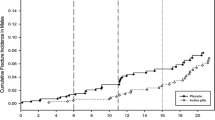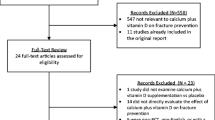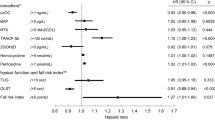Abstract
Patients with low-trauma fractures are at risk of future fractures and so should be evaluated and treated for osteoporosis. This study was conducted to assess and compare bone medication use and calcium and vitamin D intake at the time of and after an acute fracture. One hundred and six patients, mean age 66.7±10.3 years, were administered medical history and diet questionnaires at enrollment (in an urban hospital) and again 6 and 12 months later (by telephone). Of 86 patients who could be contacted 6 months after their fracture, 36.2% of the women and 7.4% of the men had recently discussed osteoporosis with their primary care doctor. At 6 months, 24.2% of the women and 3.6% of the men were taking bone medications (compared with 27.8% and 3.6% before the fracture; NS). At 6 months, 52.6% of the women and 10.7% of the men indicated that their doctor had recently recommended calcium or vitamin D. Among the women who had recently been advised by their primary care doctor to use calcium or vitamin D, supplement use increased from 63.3% to 90.0% (P=0.021) and dairy food intake increased from 1.5±1.1 to 2.4±1.9 servings/day (P=0.016). Only three men received this advice and two of them heeded it. Among women and men not receiving this advice, there was no significant increase in calcium supplement use or dairy food intake. At 12 months, the treatment profiles were unchanged from 6 months and 9.6% of the women and 4.3% of the men had had another fracture. In conclusion, the occurrence of a fracture did not increase likelihood of pharmacologic treatment for osteoporosis. After their fractures, the women did increase their intake of calcium supplements and dairy foods when this was recommended by their doctor. This suggests that the primary care physician is well positioned to bring about much needed change in the quality of care of fracture patients.

Similar content being viewed by others
References
van Staa TP, Leufkens HG, Cooper C (2002) Does a fracture at one site predict later fractures at other sites? A British cohort study. Osteoporos Int 13:624–629
Ross PD, Davis JW, Epstein RS, Wasnich RD (1991) Pre-existing fractures and bone mass predict vertebral fracture incidence in women. Ann Int Med 114:919–923
Klotzbuecher CM, Ross PD, Landsman PB, Abbott TA, III, Berger M (2000) Patients with prior fractures have an increased risk of future fractures: a summary of the literature and statistical synthesis. J Bone Miner Res 15:721–739
Black DM, Cummings SR, Karpf DB, Cauley JA, Thompson DE, Nevitt MC et al. (1996) Randomised trial of effect of alendronate on risk of fracture in women with existing vertebral fractures. Fracture Intervention Trial Research Group. Lancet 348:1535–1541
Chesnut CHI, Silverman SM, Andriano KP, Genant HM, Gimona AM, Harris SM et al. (2000) A randomized trial of nasal spray salmon calcitonin in postmenopausal women with established osteoporosis: the Prevent Recurrence of Osteoporotic Fractures Study. Am J Med 109:267–276
Ettinger BM, Black DMP, Mitlak BHM, Knickerbocker RKP, Nickelsen TM, Genant HKM et al. (1999) Reduction of vertebral fracture risk in postmenopausal women with osteoporosis treated with raloxifene: results from a 3-year randomized clinical trial. JAMA 282:637–645
Harris STM, Watts NBM, Genant HKM, McKeever CDM, Hangartner TP, Keller MM et al. (1999) Effects of risedronate treatment on vertebral and nonvertebral fractures in women with postmenopausal osteoporosis: a randomized controlled trial. JAMA 282:1344–1352
Neer RM, Arnaud CD, Zanchetta JR, Prince R, Gaich GA, Reginster JY et al. (2001) Effect of parathyroid hormone (1–34) on fractures and bone mineral density in postmenopausal women with osteoporosis. N Engl J Med 344:1434–1441
Chapuy MC, Pamphile R, Paris E, Kempf C, Schlichting M, Arnaud S et al. (2002) Combined calcium and vitamin D3 supplementation in elderly women: confirmation of reversal of secondary hyperparathyroidism and hip fracture risk: the Decalyos II study. Osteoporos Int 13:257–264
Dawson-Hughes B, Harris SS, Dallal GE, Lancaster DR, Zhou Q (2002) Calcium supplement and bone medication use in a US Medicare health maintenance organization. Osteoporos Int 13:657–662
Osteoporosis Research Advisory Group (2002) Meta-analysis of calcium supplementation for the prevention of postmenopausal osteoporosis. Endocr Rev 23:552–559
Osteoporosis Research Advisory Group (2002) Meta-analysis of the efficacy of vitamin D treatment in preventing osteoporosis in postmenopausal women. Endocr Rev 23:560–569
Nieves JW, Komar L, Cosman F, Lindsay R (1998) Calcium potentiates the effect of estrogen and calcitonin on bone mass: review and analysis. Am J Clin Nutr 67:18–24
Kanis JA, Pitt FA (1992) Epidemiology of osteoporosis. Bone 13:S7–15
Cuddihy MT, Gabriel SE, Crowson CS, Atkinson EJ, Tabini C, O’Fallon WM et al. (2002) Osteoporosis intervention following distal forearm fractures: a missed opportunity? Arch Int Med 162:421–426
Freedman KB, Kaplan FS, Bilker WB, Strom BL, Lowe RA (2000) Treatment of osteoporosis: are physicians missing an opportunity? J Bone Joint Surg [Am] 82-A:1063–1070
Harrington JT, Broy SB, Derosa AM, Licata AA, Shewmon DA (2002) Hip fracture patients are not treated for osteoporosis: a call to action. Arthr Rheum 47:651–654
Kiebzak GM, Beinart GA, Perser K, Ambrose CG, Siff SJ, Heggeness MH (2002) Undertreatment of osteoporosis in men with hip fracture. Arch Int Med 162:2217–2222
Torgerson DJ, Dolan P (1998) Prescribing by general practitioners after an osteoporotic fracture. Ann Rheum Dis 57:378–379
Cummings S, Stone K, Lui L, Hillier T, Bauer DC, Genant HK et al. (2002) Are traumatic fractures osteoporotic? J Bone Miner Res 17:S175
Author information
Authors and Affiliations
Corresponding author
Additional information
This material is based on work supported by the US Department of Agriculture, under agreement No. 58-1950-9001. Any opinions, findings, conclusions, or recommendations expressed in this publication are those of the authors, and do not necessarily reflect the view of the US Department of Agriculture.
Rights and permissions
About this article
Cite this article
Pro-Risquez, A., Harris, S.S., Song, L. et al. Calcium supplement and osteoporosis medication use in women and men with recent fractures. Osteoporos Int 15, 689–694 (2004). https://doi.org/10.1007/s00198-004-1668-4
Received:
Accepted:
Published:
Issue Date:
DOI: https://doi.org/10.1007/s00198-004-1668-4




